EQMS Blog

A Guide On ISMS Implementation Within Your Organisation
On the off chance that your association is at all worried about data protection, it should have an information security management system (ISMS).
Information security management system is a system of procedures, documents, technology and individuals that enable organisation to oversee, monitor and enhance their information security in one place. ISO 27001 plays best practice for ISMS and ensuring to the standard means you can make sure that your organisations security measures are as compelling as could be expected under the circumstances.
ISMS implementation can be a hard work and it will include your entire association. The undertaking can take somewhere in the range of three months to a year. Before you start the implementation, you have to consider your organisation size, the dangers it faces and the measures currently set up. In any case, any ISMS implementation should dependably contain these 14 steps:
Steps of ISMS Implementation
1: Conduct a Gap Analysis
This helps you to determine the regions of your company that aren’t compliant with ISO 27001 and what you have to do to end up complaint. If your organisation do not have the knowledge internally or would like an impartial assessment conducted by an independent party, it can be an advantage to use an ISO 27001 consultant.
2: Scope the ISMS
Choose which information resources to ring-fence and ensure. Doing this effectively is very fundamental, in light of the fact that a scope that is too huge will escalate the time and cost of the project and a scope that is too little will leave your association powerless against threats that weren’t considered.
3: Developing Your Information Security Policy
The security policy should contain the strategy which mirrors the organisation’s view on information security and be settled upon by the board.
4: Conduct a Risk Assessment
Risk assessments are the centre of any ISMS. An assessor will recognize the dangers the organisation faces, and gauge and assess them. The risk assessment likewise distinguishes whether the organisation’s controls are important and financially effective.
5: Select Your Controls
Controls should be connected to manage or lessen risk distinguished in the risk assessment. ISO 27001 requires associations to think about any controls against its own particular list of best practices, which are contained in Annex A.
6: Create a Statement of Applicability (SoA)
A SoA lists every one of the controls recognized in ISO 27001, points of interest whether each control has been connected and clarifies why it was incorporated or avoided.
7: Set up a Risk Treatment Plan (RTP)
A RTP depicts the means an association should go for broke to manage the dangers recognized in the risk assessment.
8: Create Your Documentation
Organisations need to document each planned control and part of the ISMS to ensure they are connected reliably and can be enhanced if important. Making documentation is the most time-consuming part of an ISMS implementation.
9: Staff Awareness Program
All employees should get general training to build their familiarity with information security issues and the motivation behind the ISMS.
10: Conduct Regular Testing
To determine if controls function as they should, ISO 27001 requires the organisation to lead general inward reviews of their ISMS. Consistent testing should be directed to ensure your incident response plans work successfully. Often organisations choose to outsource the internal audit function of their ISMS for objectivity, cost reduction and increase capability of the audits.
11: Management Reviews
Top management should review the performance of the ISMS in a management review on a regular basis. Often this is conducted minimum once a year.
12: Certification Body
The certification body you use should be appropriately licensed by a recognized national accreditation body and member from the international accreditation forum. For example for UK, this would be UKAS.
13: Accredited Certification
Your picked certification body will survey your management system documentation, watch that you have executed suitable controls and direct a site review to test the overall system and controls you have put in place.
14: Manage and Review Your ISMS
Once the ISMS have been executed, you have to keep up and consistently survey it. ISO 27001 indicates the necessities for doing this.
If you are looking to get certified to ISO 27001 as part of improving your information security, our ISO 27001 consultants would be able to support your project. Contact us for a free consultation today.

Request a free consultation
Contact us to discuss your needs and see how we can support to reach your goal.

Recent posts

In today's digital age, businesses are constantly exposed to various cyber threats. As a result, companies must adopt a proactive approach to cybersecurity to prevent data breaches, theft, and other...

Quality management systems are essential in ensuring that organisations can deliver quality products and services consistently. The International Organisation for Standardization (ISO) developed the ISO 9001 standard to help organisations...

ISO 14001 is a globally recognised standard for environmental management systems (EMS) that helps organisations manage their environmental impact and improve their sustainability performance. Obtaining this certification demonstrates a company's...
Just a Few of Our Clients
Request a Free Consultation
Contact us to discuss your needs and see how we can support to reach your goal.















